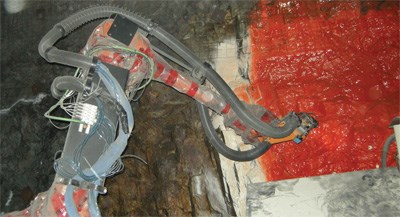Research to advance the development of thin spray-on liner is in full swing at Xstrata’s Nickel Rim South Mine in Sudbury.
An alternative to shotcrete and screen, the polycarbonate material is being applied by a robot in working areas of the mine.
“When we started our work on thin spray-on liner in 2007-2008, we were in an economic downdip that liberated some robots used for paint spraying in the automobile industry,” said Charles Graham, managing director of CAMIRO. “We saw these devices and thought if they can spray inward and downward, they could also spray outward toward a drift.”
Experts in robotics were doubtful about the applying their technology in an underground environment because “their whole model is premised on the robots having a solid foundation,” said Graham. “The cars come to them and they’re sprayed, so the robot knows where it is at all times.”
In a mining application, the robot would have to sit on a mobile piece of equipment.
Sensor head
“It has a sensor head on it that maps its environment,” said Graham. “It sweeps the area and says ‘OK, I’ve found everything.’ It calculates the outline of the opening, takes the spray gun and aligns the head in an optimal direction to apply the lining to the rock in the correct thickness.”
Thin spray-on liner is thought to have several advantages for deep mining applications. It uses one-twentieth the amount of material that would be required for the application of shotcrete and has tensile strength.
When shotcrete is hit with a seismic wave, it fails very early, said Graham. “We expect this material will expand, move with the rock face and hold, but we still have to prove that.
“At the moment, we’re spraying patches of wall, making sure it’s the right thickness and working the bugs out of applying it,” said Graham. “Ultimately, what we have to do is apply it widely enough to see it function and validate its contribution to rock stability.”
Testing the material’s ability to withstand seismic activity isn’t an easy thing to do, “because the whole point of good mine design is to not have the rock fail at all,” said Graham. “We may need to induce failure to prove it as a ground control technique.”
CAMIRO is overseeing the research on behalf of the Deep Mining Research Consortium, which includes Vale, Xstrata, Barrick Gold, Agnico-Eagle and CANMET, the mining research arm of Natural Resources Canada.
3M manufactures the lining, ABB supplies the robotics, and Sudbury-based Mining Technologies International has been selected to design a carrier for the robotic sprayer. Until now, the sprayer has been moved from place to place in an LHD bucket or bolted to a piece of steel and moved using a forklift. Design criteria for the carrier have been identified and preliminary engineering is underway.
Isocyanides
“We don’t need a robot, but the product contains isocyanides,” said Graham. “Once they’re bonded together, they’re no problem at all, but there are air quality issues with the spraying of isocyanides, so we want to be very careful about exposure.”
The alternative would be to supply mine personnel with full breathing apparatus connected to an airline, but that would be awkward, said Graham.
“Ultimately, we see it sitting on the back of a carrier. A miner would drive it into the heading, get out of the cab, hit a button on the dashboard and exit the area. The robot would sense human presence, so as soon as everyone is out of the way, it would start up, map the environment and spray.”
The material hardens in seconds, allowing miners to enter the area and bolt through the membrane.
Reducing the volume of material required for ground control would simplify logistics in a deep mining environment. Currently, shotcrete is applied a few inches thick and is either piped down or bagged. The polycarbonate material is applied in thicknesses of approximately a quarter of an inch.
Graham hopes that the consortium’s experience with robotics will open up a wide range of opportunities beyond the application of spray-on liner.
“Once we figure out how to make this robot operate in an underground setting, we can look at using it to put up pipe, vent tubing…all kinds of things.”



